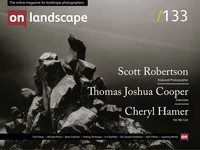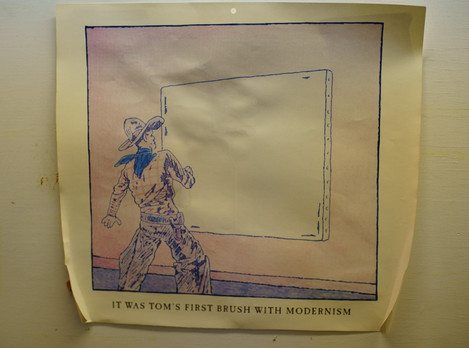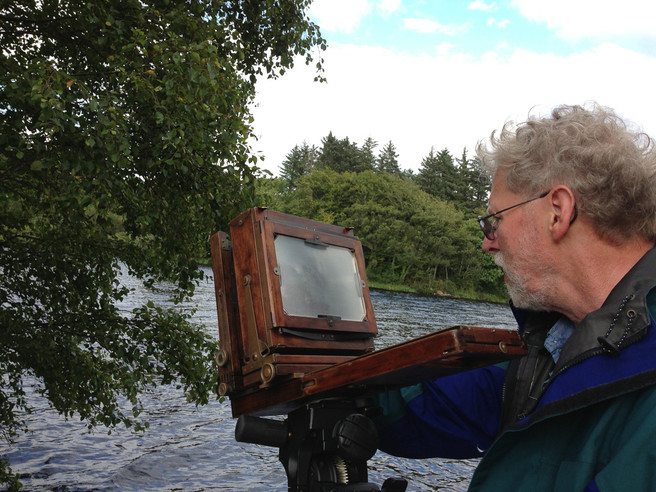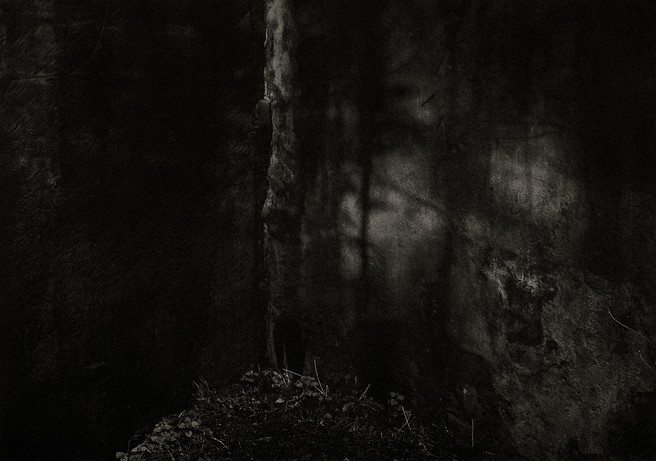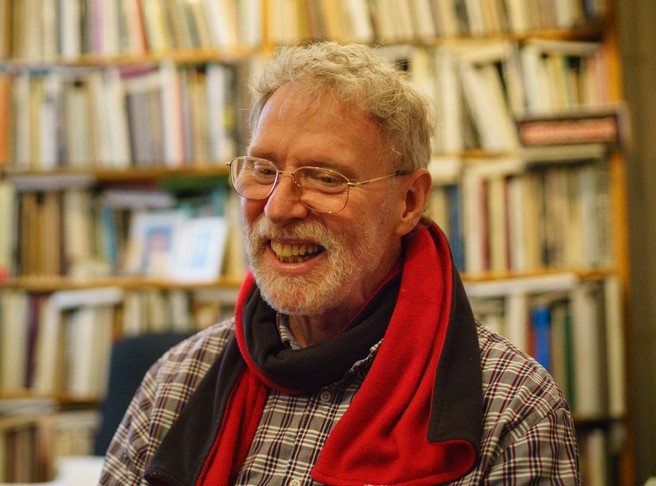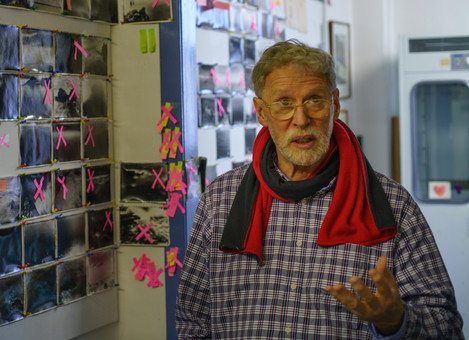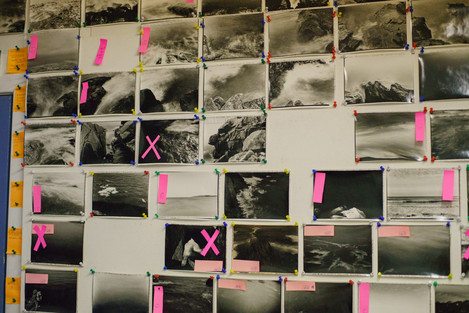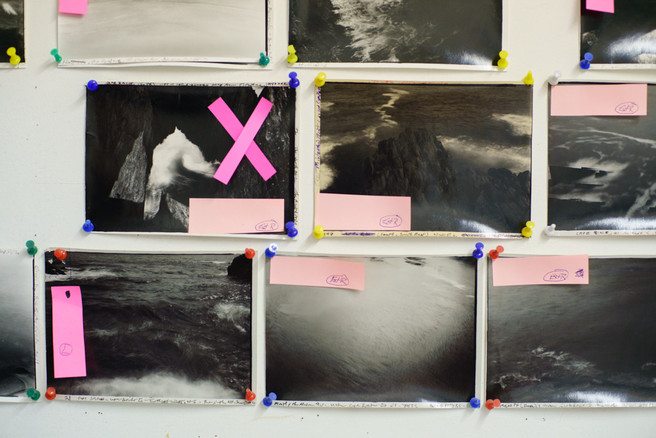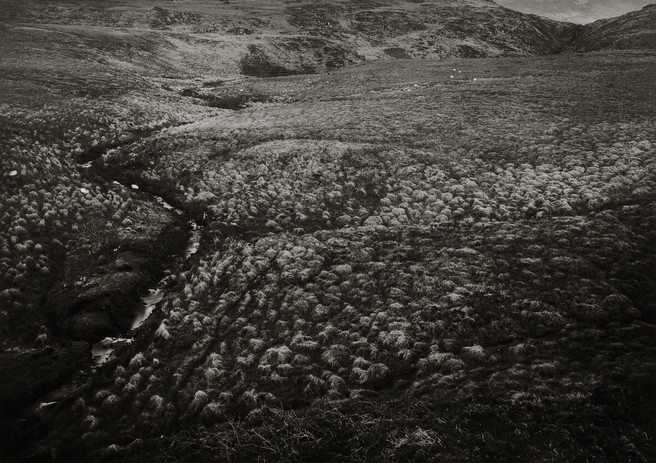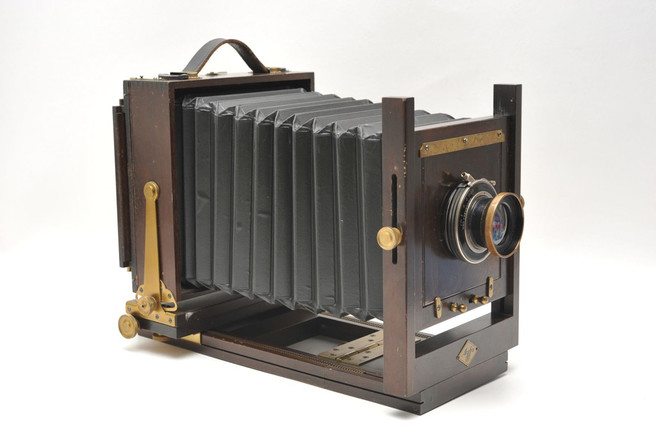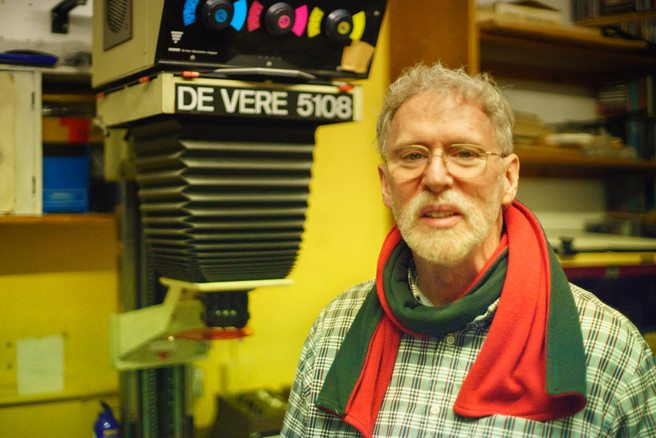An Interview

Tim Parkin
Tim Parkin is a British landscape photographer, writer, and editor best known as the co-founder of On Landscape magazine, where he explores the art and practice of photographing the natural world. His work is thoughtful and carefully crafted, often focusing on subtle details and quiet moments in the landscape rather than dramatic vistas. Alongside his photography and writing, he co-founded the Natural Landscape Photography Awards, serves as a judge for other international competitions. Through all these projects, Parkin has become a respected and influential voice in contemporary landscape photography.

Thomas Joshua Cooper
Thomas Joshua Cooper is one of the most celebrated and distinctive landscape photographers working anywhere in the world today. He was born in California in 1946 but has lived in Scotland for many years. Cooper is the founding head of photography at Glasgow School of Art but spends much of his life seeking out the edges of the world. Like artists such as Richard Long, and Hamish Fulton, Cooper is a traveller, a nomadic artist whose extraordinary photographs are made in series at significant points around the globe, most often at its extremities.
Last year, Colin McClean suggested that we should interview with Thomas Joshua Cooper, the Professor and founder of the Fine Art Photography Department at Glasgow School of Art, and with Colin's connections with the Department, he offered to help arrange it. A few phone calls (Thomas doesn't do computers, emails via third parties and a quick drive up to Glasgow and we were ushered up to Thomas' offices which consisted of a small room with a desk at one end, wallpapered with bookshelves and a large studio and darkroom at the other, decorated with test prints.
Some would call our 'interview' more of a ramble than a structured set of questions but we got the feeling that trying to herd Thomas down our own agenda might not be productive - and we had the advantage of time on our hands, which was a good job as we were there for nearly four hours.
The following consists of select extractions from our meander through photography and life stories. I present them in chronological order rather than trying to force an imaginary arc of ideas through them that had no basis in reality.
On Shooting, or Taking of Images
TJC: The idea of “taking” is anathema to me, just so I can put that in formally. Taking things, taking pictures, shooting, Jesus, what a vulgar, vulgar idea. When I was young, I was a shooter. In my family, guns were part of the deal: first rifle at six years old, for a shotgun, eight years old, first range rifle, 12 years old. You learn how to shoot things and it has a particular meaning for me. Just like taking things, you take something and all of a sudden whatever you’ve taken is gone. You shoot something and whatever you’ve shot is dead. But if you make something or you build something, what you do isn’t part of a vernacular of incipient violence and carelessness then there is the possibility that maybe something as weird as photography can have a real meaning. I mean it’s a joyful thing, this camera photographing thing.
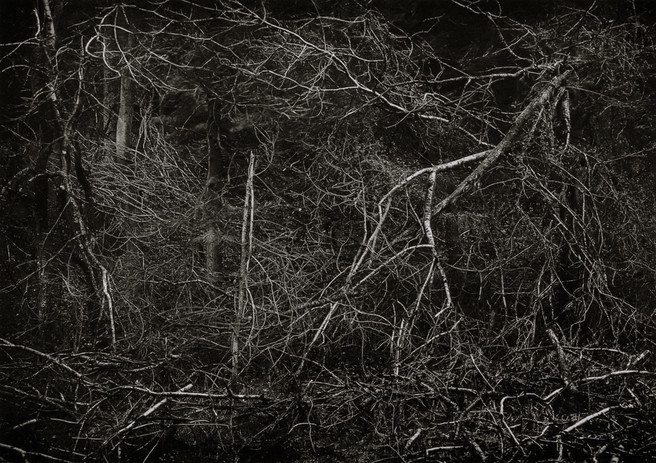
The Guardian Cycle - A Premonitional Work nr. Sonder Vissing, Braestrup Region. Denmark, 1988 pub: "Dreaming the Gokstadt."
On Academic Art Teaching
TP: When I have talked to graduates of art degrees, one of the big benefits that they say they get is talking to other people who are also trying to be creative, in a group, which doesn’t seem to happen outside of academia. Would you agree?
TJC: Well in my experience it doesn’t, and increasingly it doesn’t happen within the academic world very often. The academic world of art schools has changed fundamentally and bureaucratically for the worse.
CMcC: They’re strangled by performance measurement.
TJC: As almost any commodified kind of institution is, but there was a time where art schools were sanctuaries, they were arks; there was the opportunity for at least two of every known weird species to exist if not compatibly, at least in relation to each other in an art school environment. Increasingly that’s not the case. What’s really exciting is when you get a group of interested people together with a common cause. It is always a great thing; where people aren’t afraid of each other and they’re treated as equals, sometimes with things working well and sometimes with things that don’t work well, but treated as equals. So much is available to learn. I had the privilege of working that out really quickly over the years of doing workshops for the Inversnaid photography workshops. For, I guess, maybe ten years, a group of people who were from very diverse backgrounds, just kept coming. A group of people just stuck with me for a while. One was a priest, one was an organic cattle farmer, one was a mechanic, one lady … I don’t know what the hell she did. Anyway, a group of older people and a couple of younger people who, out of the blue just actually knocked my socks off - completely knocked my socks off. Some of the best, most interesting people I’ve ever met in my life, who came together simply because they were interested in making pictures and advancing the problem solving situations that they found themselves in whilst trying to make things that were important or dear to them. I finally stopped because I realised that this group of people were impacting me so powerfully that I didn’t have anything else to say to them, they were on their own. That I probably ought to meet with them regularly instead of the reverse. Art schools can do that. Carrying on an on-going creative conversation with people, with anybody, is a privilege.
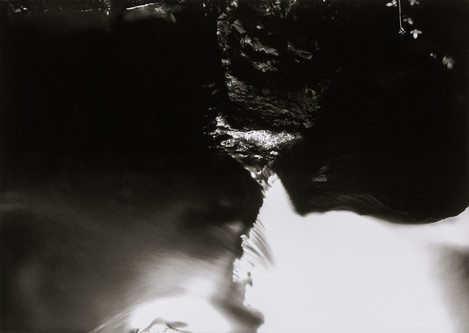
Late Afternoon - remembering lost holidays - The River Devon Rumbling Beside Gorge. Kinross-shire, Scotland, 2014 pub: "Scattered Waters."
You ask however if I think it happens, I think once you leave the context and confines of an institutional structure of any kind, club, society, school, you name it, then that conversation dwindles to almost nothing. You then either have to have the presence of mind or, as I put it, need and desire. I have no belief and/or interest in the word ‘talent’, I don’t believe in it. Need and desire is what is important. If you have the need to continue to do things and the desire to figure out how to do them better each time, then you’ll survive the lack of conversation that actually is almost utter when you move away from a community of like-minded people. That’s where it gets rough. That’s also where it gets to the point where it’s easier to do easy things than it is to try and figure out how to continue to do or try and do, new or initially difficult things. Because it’s just hard.
This I’m afraid is the creative person’s dilemma, whether you’re a writer or a dancer, a musician, a painter, a photographer, a philosopher or a mathematician or any other things that I’ve missed in between: It’s how you deal with the almost chilling silences. That is what either does you in intellectually, unless you find a way to resolve it.
TP: When you say silences, you mean from the outside world?
TJC: Yeah I talk to myself in the dark. Sad Bastard Syndrome. I talk to myself all the time but in a way just to hear in part a human sound, although my droning orifice is tedious even to me.
Yes it’s really important to have contact and that may sound silly, but you see, we learn the most from being critical and our contacts being critical. There was a very great contemporary modern art historian, an Australian man named Robert Hughes, who did a book and then a series of television programmes called ‘The Shock of the New’. He wrote an autobiographical memoir which is absolutely central to me in terms of its title which is ‘Nothing if not Critical’. Whatever the points of view, whether it’s the kind of philosophical inclination that romanticism might suggest to be a hold on people or other kinds of intellectual pursuits, what is necessary is that desire for critical understanding. This is really what is wonderful about a community of conversants: everybody’s going to know something that you don’t. You might not agree with it, it might make you uncomfortable, in my case it scares me, but that’s when I know that it’s exciting, when my guard is breached and I’m uncomfortable, I think “Okey dokey time to listen up here”.
On Photographing for an Audience or Yourself
TP: When I started photography I started photographing for an assumed audience, my friends and family possibly, but I realised reasonably quickly that the audience wasn’t really who I wanted to create for. I got to a point where I felt I’m not creating the work just for me but I have an imaginary audience that I’ve created inside my head. Is that something that sounds familiar to you? TJC: That’s a simple question but it’s a really serious one and a slippery one to answer. At a certain point in any kind of practice one moves from the private to the personal to the public, depending on need and desire. The move into the public domain is varietal and many splendored but almost inevitable if you keep practising. You know there are two or three people who are extraordinary picture makers and who have only ever remained almost really on a private level. I’ve never gotten that. They’re exemplars to me, but they’re so eccentric that it’s unbelievable. There are multiple audiences, there is not only one, as you suggest. Then I think the necessity is to make sure that while you work to the audience, you maintain the work that speaks for yourself first. Because once that disappears, when the audience determines the picture, then one is an illustrator. That’s just not very interesting to me. I’m interested in how people conscioulsy or subconsciously find out that they have a voice, that they can enjoy using the materials of photography and the camera and begin to speak their mind. Something that is actually harder to do than it is to say. Then whatever they want to say actually is really of fantastic interest to me. As I would have thought that it would be to anybody trying to struggle with not just a voice but a vocabulary. How do we find a vocabulary to say what we want clearly enough or weirdly enough or unexpectedly enough, to stay entertained long enough to want to do it more. Now that’s interesting to me. Everything else is too much work.
On Projects and Whether a Photograph has to Stand on its Own.
TP: From your point of view, should photographs stand on their own, or can they live only in the context of a project?
TJC: I think it depends. Whatever makes the work, work, should be allowed to make the work, work. I never think a single picture does anything at all. I mean there are no photographic Mona Lisas anymore, not when there’s trillions of photographs in the world. It takes more than one image to make sense out of anything. You can get lucky with one. You can get pretty lucky with five. You have to actually start getting your shit together a bit to have ten or 20 or more in a project.
I cannot approach the problem of trying to make things without a project in mind. Gratuitous image making is kind of wasteful it strikes me, it’s wasteful because it’s not necessarily effective. But having a purpose in mind makes me less embarrassed spending the time.
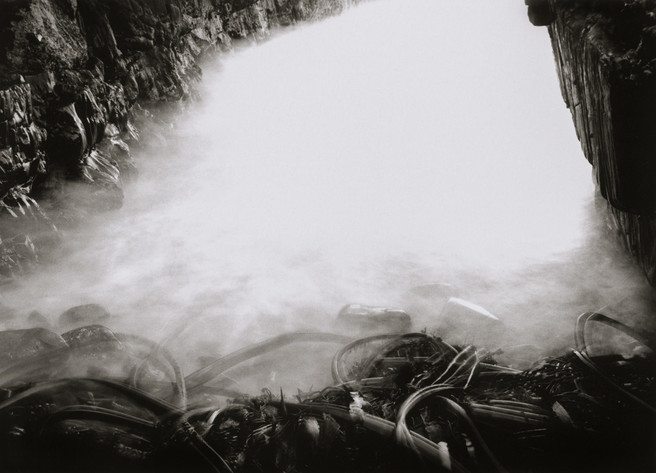
Freedom Day - Southwest - Table Bay. Looking Toward Cape Town and Remembering Robben Island, Cape Town. South Africa, 2004. pub: "Point of no return."
On Words, Pictures and the British Mentality
TJC: I think words and pictures are naturally in conflict each other. They don’t have to be, but they are natural antagonists. I am absolutely convinced (and it’s sad because I’ve spent most of my adult working life failing in this country to try and insist that photography be seen as an independent visual art) that the British mentality is entirely antagonistic and unaccepting of photography as art. I probably wouldn’t have stayed here so long if I’d had any inclination of what I think is the truth now.
There are three art forms, generic art forms, that have taken hold on the cultural imagination of the British intelligentsia and general public. The first one, figurative painting, absolutely dominated by the greatest figurative painters of the era, like Bacon and Freud amongst others and then going back on some level to figurative sculptures like Moore, Henry Moore. Then weirdly, comes documentary photography, which has an absolute hold on the imaginative condition of the people in this country. Thirdly, and not unexpectedly, conceptual art. It’s those three things that have one thing in common, they deal with literalness and the literalness is in relation to a language base of understanding. A figure is a figure. Documentary photography of a thing is a thing. The word base generally of certainly early conceptual art at least was transferable in terms of understanding, based on language.
The point I am trying to make then is that the English language is so absolutely, deeply, formally embedded in the sort of cultural structure of the imagination that anything that moves towards abstraction or tries to make a contra distinction of what realism is, and therefore what is related to how a word makes sense, has real serious problems. There is for instance, excepting Salman Rushdie who quite clearly is an Indian writer, no magical realist in the English writing tradition. That understanding of how to approach language magically is what the best of art can do and the best of artists. But three things, figuration, documentation and conceptualisation have taken hold in a way that, actually, there is no going back. There are almost no great abstract painters in British history. I could get hammered for that, but it’s a generality that’s not entirely incorrect. Every single maker who is considered a decent artist photographically in this country, an artist at a high level, is a figure or portrait maker. There are people who have moved through the documentary genre into being considered artists and it just irritates me because to me, the best at something for instance, Martin Parr, does actually incline one to believe that there is artistry involved. But I’m not convinced, I’m just not convinced. Forgive me for saying it, but for the most part the landscape tradition, which is really interestingly being rediscovered in the Portsmouth area, has taken no consideration of the British land artists, who actually reinvigorated the landscape and the realism of landscape in relation to language as well.
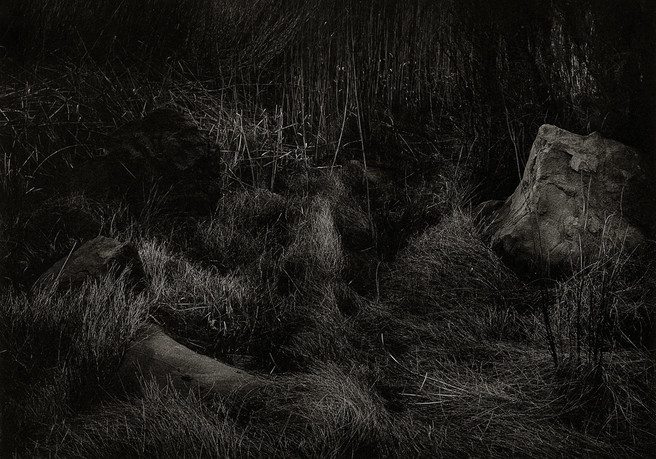
A Quality of Dancing - Ceremonial Dwelling (small animal nesting ground) San Jose Canyon, New Mexico, 1973 pub: "Between Dark and Dark."
TP: By British land artists do you mean the likes of Goldsworthy, Long and Fulton?
TJC: Yes - they changed the game and yet in some ways poor old Andy, whom I admire greatly as an image maker by the way, is seen too often as an illustrator. A lot of his age group colleagues are in the same situation and there’s been no-one to take on the challenges or tasks of Long or Fulton, no-one, and that includes all the essentially documentary based landscape work coming out of the Portsmouth school if you will. So I mean where does this leave art in relation to photography? It suggests there is a real big problem. Where does that leave the thinking process?
So how for instance, where for instance and when if ever, for instance, is anybody going to ever figure out what made Eggleston’s pictures so tremendously exhilarating in terms of their colour. Photography has opened up so many questions in this country, almost none of which have been dealt with culturally and what we have unfortunately, and including what I believe to be the demise of the particular programme that I once led, is basically an unspoken realisation that, at least in Britain, photography isn’t an art. It is a material process in the use of illustrating things for other purposes.
I can’t believe that I spent a lifetime in a place where the language is so vital, going back to the pictures and words, only to have the recognition that the language is so strong that it stifles the understanding of how to use materials that don’t find themselves easily described within the context of the language. That’s a real problem for me. So you didn’t want to hear this but … so there are two choices, turn and run or stand and fight.
I regret … I only have a few regrets, but I have a genuine regret that I never made a substantial body of colour work. That was stupid, but I had other things to do. I didn’t have the time. I would try to figure out how to use colour to start scaring painters. That’s the very first thing to do, in the same way that some of the best painters are figuring out how to use photographs to start to scare photographers. I spent 20 years trying to figure out how to be a photographer, always hoping I might sometime be an artist, always, only ever, ever wanting … but realising I wasn’t good enough.
TP: What are you now?
TJC: Oh I’m only an artist. I’ve earned it!
On Skills
TJC: I was once told … and I’ve come to believe it very intensely, that it takes as long to figure out how to make a real body of photographic work as it does to become an accomplished concert pianist and I was told that that was an approximate 15 to 20 year period. It’s easy to acquire the skills and then it’s easy to make things look like things that they ought to look like. In other words, to copy pictures that are already out there, illustrations in my opinion. But it takes real time to figure out the voice or the score and, in my kind of interests, more time yet to become familiar enough with the tune to find a way to improvise with them. That’s where the joy is, knowing the tunes and also knowing that if you play enough you’ll find a way of playing the tune anew. That’s brilliant to me. Whatever it’s called, I don’t even care at that point. The musical lesson for me is, of course, the implicit recognition that music is structure. There is a structure to the form that makes the sounds, but within that the great continuing discovery is in this thing tunes and how to find a way to play groups of tunes the same, anew, differently, over and over again without it actually becoming a copy of one or the other. Improvisation.
On Composition
TP: Well that probably brings me onto another question, which I think you might have an opinion on. Formal design, formal patterns, composition, the structures of pictures: I was looking at a video of your work, ‘Carry Me’ at the Lannan Foundation (http://podcast.lannan.org/2015/08/15/thomas-joshua-cooper-carry-me-gallery-tour-video/).
TJC: I’ll be damned, yeah, God. I’m so proud of that. That title, the Curator hit it so hard. He’s one of the people I trust most, outside of my wife, in the world.
TP: Looking at that work, there was obvious passion for the subject matter in there, I can see, but also there’s for me a recognition that you have thought long and hard about how the pictures are structured.
TJC: Absolutely.
TP: In terms of structuring, how did you … how do you develop those skills?
TJC: You know that’s a good question, but Jesus Christ, if I answer it in the way that I could it will sound so glib. In my particular sense I saw groups of people’s pictures that I was drawn to, inspirations, I hate very deeply the idea of influence, influence by its nature is for me fascistic, spheres of influence are only about power bases. Inspirations on the other hand are either sort of the good luck of finding something wonderful and falling in love with it or just being overwhelmed, zonked. The reason I talk about making pictures is that I build them. I have this saying to myself, locate the edges and the sitter will take care of itself. Then when there’s no edges I have a different saying. But those two things are key to how I go out to try and make something outdoors. But then how I learn … because it didn’t come naturally I guess, or maybe everything is natural and it didn’t come easily, I was deeply taken, and probably always will be, by small groups of Alfred Stieglitz’s later work, a large chunk of Edward Weston’s Point Lobos works, his last works in particular. His last works really intrigued me as it turns out. Then of course a couple of things that Minor White made. Then two pictures by Paul Caponigro that everything I did early on were based on; he’d just passed them over, so strange.
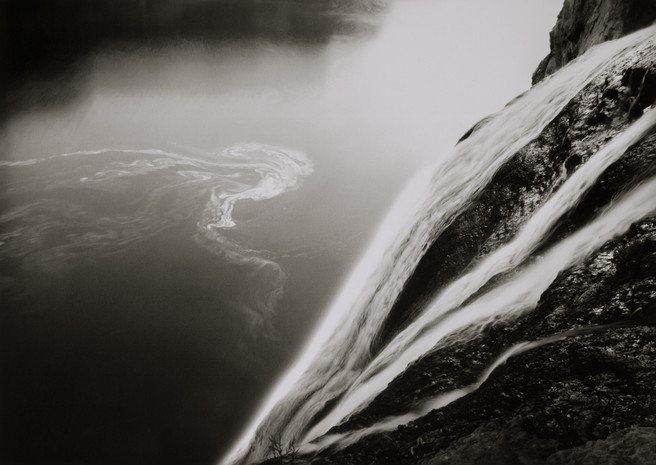
"Bridal Falls"" - Shoshone Falls - The Snake River Basin The West Bank Rim Top, Jerome County, Part 1 of a 2 part work, 2003-2004 pub: "Shoshone Falls."
TP: Can I ask which two they are?
TJC: They’re in his smallest book called “Landscape” which is an old paperback, it’s a turquoise thing, it has two pictures in it, horizon-less things that he just didn’t see. He made the pictures and I talked to him about them, he didn’t see them, so stuff him - they’re mine.
What I learned from these guys, in distinction to the greatest inspiration of my photographic life which was the nineteenth century picture maker Timothy O’Sullivan, was something that was really of intuitive but unspeakable importance. And that was interiority, how something often without a horizon, outdoors, could have the equivalent feeling of being inside in a room, in a place, but still being outside. It’s really seriously important to me.
I think I realised that for what I wanted to do photographically, the first thing that had to happen was to be able to interiorise the outside to make sense out of it, to remove it from being an ‘out there’, a place away, to at least pictorially suggest an ‘in there’ or an ‘around there’ type of place.
There are varieties of ways of doing that. The first was to absolutely demand the removal of the horizon from the outdoor and that removed a figure-ground relationship, the triangulation of where your feet to a place to go to and then the opportunity to go. Generally speaking horizons move you out of the picture faster than you can be in it. I use them very specifically now for very particular things and enjoy them enormously, but for a long time I refused them. Then my original interest, although of course Christ you know, like everybody else, I first fell in love with people like Eugene Smith and Cartier-Bresson, documentary photographers, both of whom … (although Henri lived too long … lots of old people, including myself, talk shit too much you know and you have to be really, deeply careful of that. I may be doing that in this conversation. )
Even in their pictures I saw what it is when you go out to do something and you have a feeling for the doing of it that is different than the expectation of what the thing might initially just look like. And I was like everybody else, just killed by those guys and I studied the work by them and I initially made pictures of people for five years and then I became more and more interested in what was surrounding the people, rather than the people themselves.
By the way I mention pictures and I should add that I distinguish a photograph from a picture, a photograph is anything that comes out of a camera, a picture is something you make. I love lots of things, including lots of photographs, but I only want to make pictures. I’ve tried really hard to be consistent about that for every moment of my work in photography. I just wasn’t very good at it for a while.
In order to graduate from my university I had to take an art class which I put off doing for a very long time because I couldn’t draw and my family had heard of Picasso but we didn’t know who he was. I was a real working kid, a lumberjack, a lumber mill worker. I went to university to read and I read History and English and Philosophy and thought that’s fantastic. Anyway, photography in the school I went to was listed as one of the drawing classes, I thought fantastic, any dumbo can take photographs, even me. I didn’t even have a camera. I borrowed a camera, the first project, go out, isolate and discover visual form. I had no idea what the guy was talking about. I’d spent five years previously studying historical, philosophical and literary forms, I had no idea what visual form was, I had absolutely zero clue. So I made 35, 36 exposure rolls of squares, triangles and circles and they were stupendously, stupendously boring and the guy failed me in the first class and, in front of 20 other students said “ Look man, photography obviously isn’t for you”.
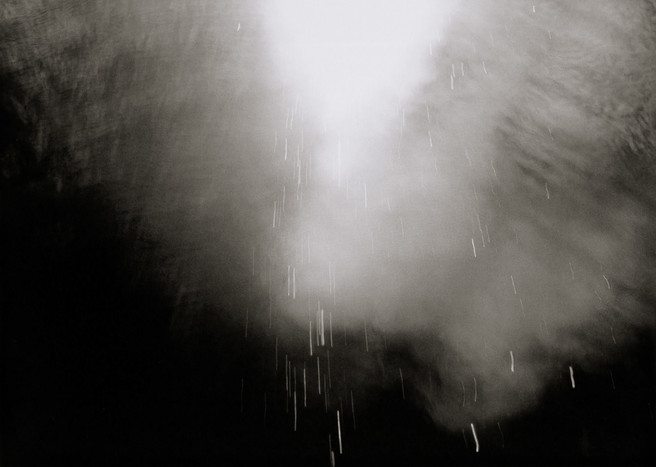
Near Kolgróv. The Isle of Ytra Sula. Norway, 2004-2008. Very near the West-most point of Norway. 61°01.099‘ N pub: "True."
His disgust with what I had done was so immense … I mean I burst into tears because I knew I was screwed. If I couldn’t do a photography class; I was never going to graduate. It had taken me six years by then. I begged him for one more chance, he got embarrassed and he gave me the chance and then other things happened, the project was about form, finding a voice, photographing people, which I didn’t do. I was very unworldly so the camera was an excuse to get close to people that I wouldn’t have normally had an idea for a social conversation with. But at some point I literally bumped into a painter who changed my life, named Maurice Graves who did a group of paintings, of which several now are in the Museum of Modern Art in New York, called Blind Bird. He made paintings of animals in a kind of an inner space but he developed a painting style called white writing with a guy named Mark Toby, more prominent.
I thought god, I really get it… without knowing why, why these white graphic marks in deep interiorised space of say a sense of bird flight or of settling wings or scrambling animals, makes sense and I realised that I could find that same kind of marking in branches, in the movements of water. From then, very quickly I understood this drawing exercise. Actually it’s the drawing that is what’s compelling to me about interiorising these spaces. I just have to find something to interiorise and draw.
My very first photograph that I count as a real photograph I made, I made a decision on, probably appropriately, apocryphal but true, on April Fools’ Day 1969. I did an eight-mile walk to the coast of Central California through a canyon called See Canyon, and I walked through this thing and I thought I’m bound to find something in a place called See Canyon. I walked the eight miles to the sea with all my gear and I didn’t see a god damned thing that I could photograph. I turned around from the crest of this hill down that looked down to the ocean and looked back the way I came and I saw something that I’d walked past. It was the picture that I’d been waiting for and I made a decision right then, one picture, only ever outdoors, generally interiorised and here we go.
But the problem of drawing, finding the edges and letting this improvised centre take care of itself, became instant; why? I have no idea. But it was a real picture, a broken tree on a creek bed that had weathered to silver. Leafless of course, bold, dead, silver, falling inward and pointing towards a dilapidated, disused cabin with five windows. I thought, “I don’t know what this is about but it means something” and that was the beginning.
So formal things are probably a little bit cloying to begin with in terms of metaphors, thank Christ it’s a lot more open now, the product of age and unwillingness to be too embarrassing, but always studying how a thing is built and then trying never to make something simply gratuitous.
You know if something’s wonderful you have to make it and there’s always that joy, but just pumping film through the camera to begin with, hmmm. There’s a Czech image maker called Joseph Koudelka. He and I were friendly and we ended up in the late seventies on the same lecture trail and he would go first because he was the famous one and I was the mutt so I would go last. Everybody would ask him, how many pictures he’d made and he said “I made so many pictures that you can take my negatives and tie them in a bow and loop them around the face of the Moon back to the Earth”. I knew I wouldn’t be able to give as good an answer when they asked me the same question because at that time I had made maybe a football links worth of pictures. But nearly every single one... I don’t miss.
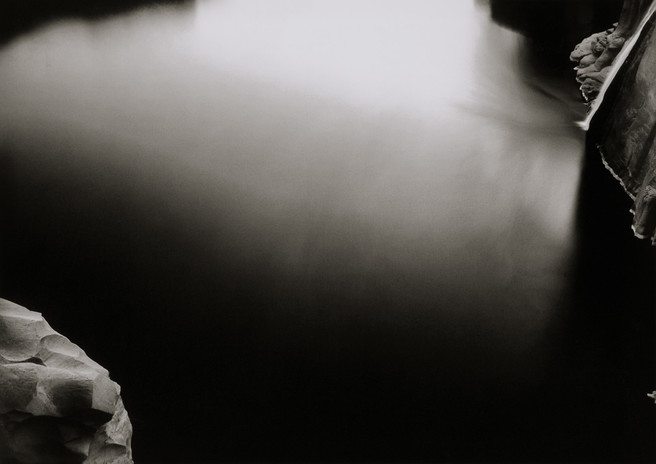
Lingering Twilight - The First View - Shoshone Falls Centre Rim Top, The Snake River Basin. The Twin Falls and Jerome County border line, 2003-2004 pub: "Shoshone Falls."
On Slowing Down
TJC: Slowing down, slowness has become part of my subject matter, one camera, one lens, film, blah, blah, one picture, one place. Part of the pleasure is of course in relation to that slowness, the condition of slowness, which I’m really interested in. It changes the physiology of viewing, dramatically.
It’s about gazing as opposed to glancing. Two primary conditions, not oppositional but not necessarily in the same kind of frame. One condition is about acknowledging the pleasure of the glance, and it is fantastic. I can’t do it though. I was never ever able to do it, in spite of my love for Cartier, my admiration for Koudelka, my devotion to Smith and more particularly Robert Frank. There is a point at which glancing has the same capacity to pierce, as gazing. The pierce is what I’m interested in. I just can’t do it though. I’m clumsy, I’m slow brained and I’m really physically awkward.
I like something as you say on a tripod, it makes it a hell of a lot easier, rocks don’t move so fast I can’t focus them you know. It’s just a hell of a lot easier for me to do what I want to do. The sea becomes a bit difficult as it turns out but I’ve learned how to deal with that a bit over time. Where to place focus on a moveable plane with the passage of time added to the problem of focus is an interesting set of dilemmas for certain types of pictures.
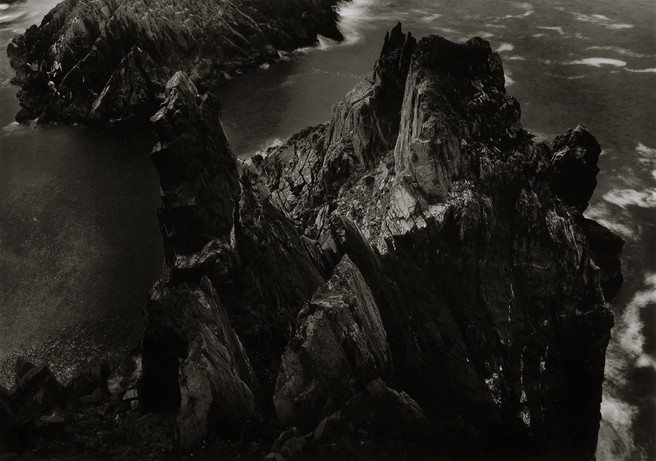
Divided - A Premonitional Work Malin Head, County Donegal, Ireland, 1986 pub: "Dreaming the Gokstadt."
On The Move Towards Serious Work
When I was younger I was sure that I knew what some of that harder stuff could be and perhaps I could push people towards it. That’s rubbish. People don’t need to be pushed, they find what they need. Need and desire, they articulate themselves given the passing of time. When people can, they do.
TP: I think a little bit of a catalyst and a little bit of a view beyond the wall can help people.
TJC: I’m glad you’ve said the wall because you know, when I talked to Caponigro about the two pictures in his book that I mentioned earlier, I said that people like you and others build walls and those two or three pictures for me funnily enough are not only just stones in the wall but weirdly, from an elevated point of view, the wall seems whole and impenetrable, but from a plan view there are holes in the wall. What those two or three pictures in relation to others, then in relation to my final understandings of O’Sullivan, allowed me to crawl through a hole in the set of walls and think that the walls aren’t there anymore, it’s fantastic. Wherever they are they’re not in front of me and that’s just great.
On Photography as Pastime or Job
TP: Would it be better to try and find a job in photography and accept the restrictions this might make on your practise or would they be better trying to find a job anywhere and have the creative freedom that comes from not having to earn a living despite problems with time?
TJC; Well, all I can say is that I did the latter. Then they began to overlap. I realised when I had a choice, which I didn’t know that I had of course, as a younger man, that I really only ever wanted to be a teacher and an artist. I thought well I might well be a teacher but I’m probably never going to be able to be an artist. As it turns out towards the end of my weird little game it’s the artist that I’ve become and I’m moving out of teaching. But I didn’t know that I had a choice because where I came from male children did really three things: they were in ranching, the lumber industry or commercial fishing. Of course there were businessmen and teachers and a few doctors, but my type were rangers, loggers or fishermen. My father was a rancher, I get hayfever so that was out. Fishing was out as I get violently seasick, although I spend a lot of time on boats in the middle of nowhere these days. I couldn’t be a fisherman, although that’s really where the money was in the bad old days. So that left logging and I loved it. I cut down the things that I photograph now. Bad me! It may sound crass but with the peculiar sense of being a parent of children who are rubbing up against the time of their lives then they are growing up and finding things difficult, my only hope is that they do whatever they want to do that makes them happy, nothing else. I don’t come from money, I come from working people, we didn’t have any money, I don’t have any. It’s weird that I realise that, not unlike many of my generation I suspect, I’m making less than my father did. Quite humbling. But you know, if my kids will be happy then it’s a reduced expectation and in a way a melancholy one as well as a joyful one. But that’s all I want for them, happiness.
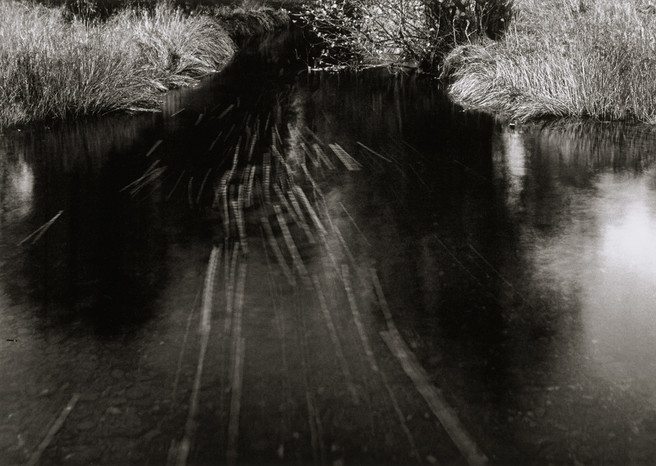
Mid-Morning - The Source Stream of the River Forth rising from Loch Chon Near Inversnaid, Stirlingshire, Scotland, 1997 / 2014 pub: "Scattered Waters."
Professor of Adventure
TP: So going right back, I looked at a lot of your stuff and I’m a big fan of Timothy O’Sullivan and Carleton Watkins, the approach of the “explorer photographer” and your working process seems very similar in that to what they’re doing but they had an externally imposed task from Washington to go do something. You create your own task and a lot of that seems to be about the adventure
TJC: Absolutely. It’s funny, it took a long time to figure out what made sense out of this weird project that I came up with; that has guided me and haunted me since somewhere between 1988 and ’89, but that came into physical being in 1990. Finally something is happening. I have a date in the autumn of 2019, if I am still alive and even if I’m not, hopefully. The Atlas show is going to be produced by the Los Angeles County Museum of Art, toured and with any luck at all, hopefully it’ll end up at Tate Britain. But you know, they might pull out. Who knows, they might never have pulled in. Anyway, this idea that’s led me to travel around five continents and both poles is maddening to be honest with you. I thought I had the big idea, I knew it and no-one’s ever done it, no-one will ever do it if I don’t. I’ve worked now 26 years on this goddamned thing and I still have three more journeys, a big one, the last big one this summer if it happens, finally the Atlas as a journeying process is complete.
TP: Where are your last three locations?
TJC: I’m doing a small New York show in 2018, a museum show. I’ve put off doing work in Long Island and Manhattan and the bottom of the Hudson for that. And then a medium sized one I’m working on where I’m trying to make pictures along the trail of the zero degree meridians which of course I can do relatively easily in England, France, Spain and the top … in Algeria. The bottom bit in equatorial Africa is a problem for me, just because it’s so unsafe right now. But it’s on the cards so maybe. Then the big one is the final journeys to the north most point of the continent of North America, a place called Zenith Point and then the north most of all North America, a place called Cape Columbia. Cape Columbia is probably one of the five hardest places in the world to get to and I’ve spent years trying to get to it and not being able to. It’s a three-month dog sled, one way, which I just can’t do it, it would kill me, six months on a dog sled, no possibility.
CMcC: Too remote for a helicopter?
TJC: Well actually it would be perfect. It’s what I dream of. My preferred mode of travel. It’s a maximum of a weeks work in a helicopter. But the nearest airbase is 750 miles to the south-east, it’s a placed called Station Alert and it’s one of the Canadian spying stations or early warning stations and they do not allow civilians in there and I have been told that they don’t actually have a Chinook level helicopter, a long distance helicopter there, they have a pissy little thing that can go 150 miles and that doesn’t help me at all. It’s on the top of Ellesmere Island, it’s 1,500 miles long, so what we’re doing now is caching fuel for a bush plane with tundra tyres and skis to leave from the bottom of the island and then a three week trip to try and get to the north most of Cape Columbia, the north-west and the north-east most. But finding pilots who will be willing to go out that long is difficult and we’re legally required to have two. And then, because this place is in the north most Canadian park, the park rangers have only given permits under the condition that one of them, the boss, flies out for free with us to get to this place because no-one’s been there. Well the last people that went there got there by breaking through the ice in a nuclear sub and then rowing ashore. I don’t know what the place looks like, which is great because I don’t do the Google nonsense. If it all goes well, I will make the picture on the continental north most point.
If I can get the picture made at Cape Columbia then I’ve completed the arc of the extreme north, south, east, west of all five continents and both poles surrounding the Atlantic Basin.
It’s more about O’Sullivan as opposed to Watkins. Watkins was a wonderful photographer but he stayed in California and Oregon essentially and they were very easy rides for him you know. He made beautiful pictures, one or two in particular with Seal Rock which I’m very, very fond of, but they’re easy money. O’Sullivan on the other hand, he was what I call in the field. Some of the earlier stuff that Muybridge did in the field, although much different, some of the more problematic things of Jackson and Russell and those guys, they were field based men.
I learned from O’Sullivan that even though he was told, do this, do that, what was great is that for the most part, as you well know, no-one was there telling him what to look at. So his brief was particular but his interpretation wasn’t specific and I love that. So I finally figured out that I could probably, justifiably, in some need for some kind of identification of purpose, term myself an expeditionary artist. I’m probably the last expeditionary artist in the history of the world. That poor bastard that died so close to the completion of his walk recently though, those are the real deal. I do real expeditions, there’s no question about that, but in the sense that there are explorers and explorers and I am an artist.
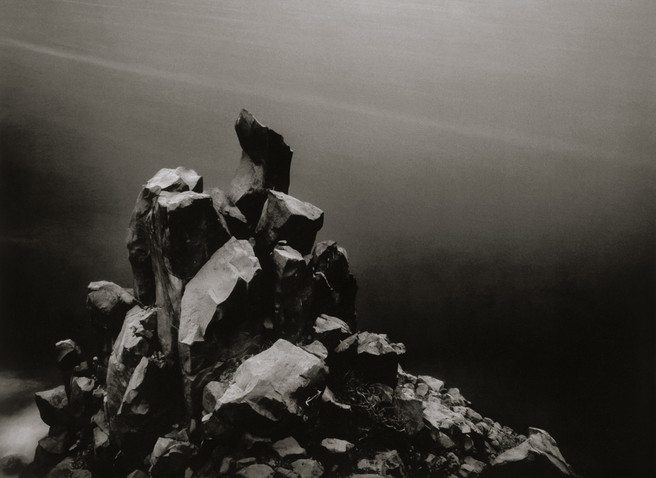
Moonlight - West, Southwest - The Mid-Atlantic Ocean Cap Manuel, Dakar. The Cape Verde Peninsula, Senegal, 2004. The South-most point of The Cape Verde Peninsula. pub: "Point of no return."
On Photography as Focus
TP: I’ve got a colleague, Alan Hinkes, who is the first Brit to climb all the world’s 8,000 metre peaks. He’s actually a pretty talented photographer and he has spoken to me about the mental difficulties when you’re working at 8,000 metres. I asked him, did the photography help and, surprised, he replied “bloody hell it probably did”.
TJC: Because of course the concentration. That’s a really smart question. I often am on small boats to get to places and in dinghies in survival suits to get onto cliff faces that are very awkward to get onto and I’m very awkward. I have actually discovered three uncharted sites in Antarctica, which I am exceedingly proud of. I’m afraid of heights as it turns out as well, so I’m on cliff edges with difficulty getting all my stuff in waterproof things and me in freezing water usually, onto cliff edges and then trying to find a way to set the tripod up and make a picture but once the dark cloth is over my head I’m at complete peace and I know what I’m doing and I can make the work and everything else around me as a distraction or as a disturbance or as a difficulty, does not occur.
On the last big trip into the Canadian arctic I was making a picture of a rock face during a six week window of opportunity, and of that six weeks probably only four weeks are useable, but it’s also Polar Bear season. We watched a Polar Bear climb a ridge watching us come into this site that I had to make a picture on and it suddenly disappeared. You always, always have to have a rifleman. Bears are big, they can do ten foot jumps and make it look simple. They run faster than deer and in short distances they can swim faster than a seal so you really can’t get away from them. And they’re bigger than a Grizzly Bear, which I didn’t know.
There are five levels of Polar Bear experience of which I’m now at level three, level five is you’re dead. But I’m making this picture and I had a wonderful crew, three really stupendously well trained young Scandinavian men helping me. I got a tap on the shoulder, get your gear, get into the dinghy immediately, don’t hesitate, there’s a bear on the rock above us. I said I have to finish the picture and the guy said, get in the dinghy now! I managed to finish the picture, pissed about the interruption, I literally got the shit together and almost thrown into the dinghy and I never saw the bear until after the fact. But the rifleman was down on his knee with the rifle ready to shoot the bear, It was 20 metres away, it’s a ten foot jump, so whatever ten feet is and the lead guy from Svalbard who’s been around bears a lot, he’s young but he’s extraordinarily experienced and fearless, started throwing rocks at the foot of this bear to just get its attention away and to hopefully startle it … and it actually worked. But we were at level three, imminent attack. But the point I was simply going to try and make is that I didn’t feel any danger until the picture was done.
CMcC: There’s a moment when you are intently composing a photograph… I don’t think I’ve ever done anything else where I’m so fixed. Moments when I get my tripod out and start to assemble it. I just love that experience
TJC: It’s a very beautiful moment and its cerebral and a genuine experience.
CMcC: A lot of people don’t experience it.
TJC: Well that’s okay too, they’ll experience something else but you can damn well bet that you can tell pictures that are the result of glancing and tell pictures that are the result of gazing and I’m interested in that process. There is something that seems so fixed about a camera on a tripod but actually you realise that that moment is actually the beginning of the process as opposed to the conclusion of it, prematurely. This whole series of improvisational possibilities that are just so wonderful.
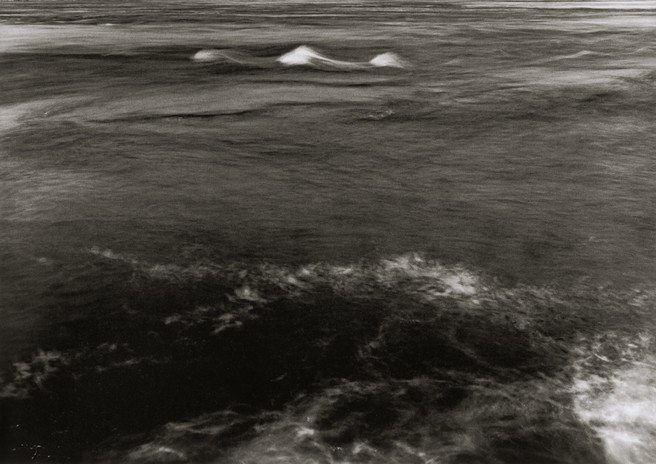
Whirl - the Sea-River - early Evening - the Spring High Tide at Flood The Corryveckan whirlpool. The Gulf of Corryveckan. The Isle of Jura. Looking toward the Isle of Scarba. Argyllshire. Scotland, 1991/2014 (a three part work) pub: "Scattered Waters."
In a Rubber Inflatable
TP: I believe you were an illegal immigrant at one point in your adventures?
TJC: Yeah, in a dinghy. I had an older guide that took me to the top of the north-eastern point of Mexico what I know of as the Rio Grande, but what they call the Rio Bravo, meets the Gulf of Mexico. I’d worked the other side of the Rio Grande, in 2009 and latterly in maybe 2006. Anyway, I kept thinking, “what would it, be like to be a wetback”. I said come on, I know it’s a five mile sand track to the main highway on the American side and there’s not a soul, you can’t see a soul, there is no-one there. Let’s swim across the Rio Grande and be wetbacks together. He said, "I’ll get arrested". I said "there’s nobody to arrest you and I’m going with you and I’ll be the one that gets done, not you." "No, no, no", he said. In the end he finally agreed and we went to a truck stop, got some truck inner tubes. We stripped down to our underwear and left my passport and ID in his truck and got into the river. So much water is drained out through irrigation that this great river doesn’t seem so great. But you get about half way across and the tidal pull occurs. Then we had problems! You know we were two old guys paddling like crazy to try and get across to the other side and we finally made it. It’s so emotional for this old boy, and actually for myself as well; so humbling. We spent enough time to catch our breath and daftly put our names in the sand. So silly. It was just one of the weirdest, sweetest things. Both of us for various reasons when we got back to the truck, started crying. He thought he’d never see the Rio Bravo, let alone get to America and I don’t know what I thought, but I totally bought into the experience… what kind of price you pay to try and realise a dream that may not ever come true. It was pretty interesting.
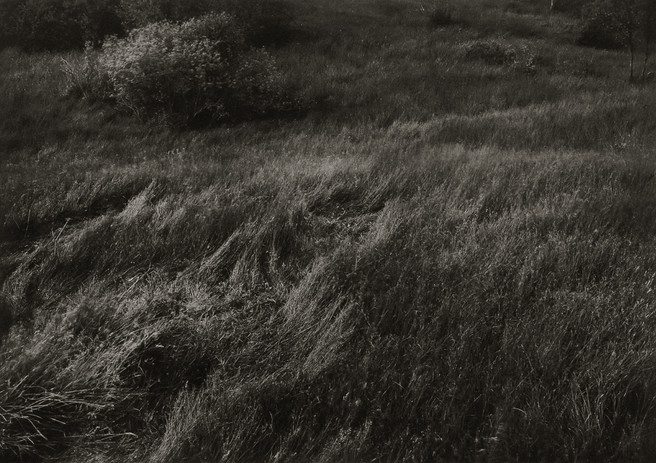
An Indication - Ritual Ground Ledlewan, Old Stirlingshire. Scotland, 1988 pub: "Dreaming the Gokstadt."
On The Moment of Capture
TP: Just going back to this moment of the capture when you’re under the camera. Because you only take one picture, what is that moment like? What is that moment like of shutter release?
TJC: When I see the … when I find the picture, when I see it, when I know I’ve built it properly, depending on the weather because weather is always in the conversation, sometimes it’s a remarkable hassle, like this last trip in November when I was along the Canadian great lakes for 5,000 miles, it just snowed and rained the whole god damn time. High rain and wind is a problem. Snow is sort of okay. Sand is the worst thing. But the high wind and rain really; it’s a wooden camera, everything goes wrong. But when I know it’s right you know, often enough and especially if it’s both right and what I think of as good, I just start laughing.
CMcC: Do you build a picture at times before you set up the camera?
TJC: I see the spot before I build the picture if that makes any … I always know. It requires concentration to see what you’re looking at, to look at what you’re seeing and to see what you’re looking at, because you can’t take anything for granted. Generally speaking I’ll find the site within three to five feet and then mess around with the tripod in that three to five foot area, finding a vantage point. Sea level is awkward because to interiorise something that sometimes has beach in it is very tedious. But you get what you get.
And that’s the other thing I’ve learned, the thing that I make, sometimes they’re really good and sometimes ... there’s a cartoon on my cupboard from the New Yorker that I saw and cut out. It says, “Hotdog Salesman”, and he’s talking to a customer and saying, “This is my studio you know, it’s where I make my hotdogs”. I think of the various types of studio where I make the picture, my hotdogs, and sometimes the hotdogs are good and sometimes they’re crap and sometimes they’re just ordinary, but I make them every day. The first studio is in here [taps head] so I think of a place to go to and I finally try and get there, close to wherever there is. Then getting to the site and placing, looking, finding a site that makes sense, placing the camera, three aspects of the same thing. Then making this picture that process is always clear to me, I don’t know why. Sometimes they’re not very good but they’re always clear. I mean there’s no mistakes anymore that are acceptable. What really kills me is, and it’s such a nuisance, is that I’ve had so many issues caused by x-ray damage to the film that it’s almost prohibited me from working in North America, they’re so difficult to work in. I mean two or three times base level fog exposure, two to three times. I’ve had to learn how to print through that. It’s incredibly awkward.
There’s things that I call field stress, which is damage to the camera that occur from lugging the damn things around and bashing them in their various protective cases, things happen, they’re not pristine. It sounds a little crass, but when I say the view through the ground glass is upside down and backwards, then I know as I often do, that this is the picture that I need, that is pure. If I am ever really happy outside happiness with family, it’s at that time. It’s maybe no other time. Because then making the images physical, making the prints is just always just hard, hard work.
CMcC: Is there another moment though when the image appears in the darkroom?
TJC: It’s a delight. Of course that’s a delight to see the negative, it’s a thrill, especially if they’ve not been too badly damaged by x-rays or not at all sometimes. Then seeing the print, it’s a joy. But that’s the hard work. There is something about the actual making inside the camera that of course it’s work but I want all my pictures, and the best of them I believe have this: to appear effortless.
It sounds stupid, but they really are labour intensive; they’re hard to get to the places, they’re hard to make physically, but that moment where I see something and it looks like it might be effortless, just there, nothing else, just there. I can retrieve those moments in looking at the negative and looking at the print, those moments of retrieval are incredibly labour intensive. That one moment where the unexpected comes, because I never expect anything anymore, I hope a lot but I don’t expect anything, when that happens, by Christ I think well you know, there we are. I’ll show you a couple of things in a minute that’s just proof forms in the studio, the kind of stuff I’m talking about, to see if it makes any sense.
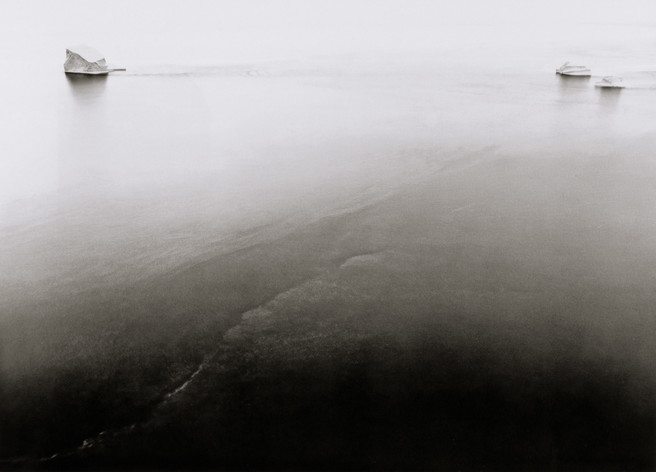
Kangertittivaq / Scorebysund - The Denmark Strait Kangikajik / Kap Brewster, 6 a.m. Liverpool Land, Tunu / Ost / East. Kalaalit Nunaat / Grønland / Greenland, 2007-2008. From the longest fjord in the world. 70° 09.097‘ N pub: "True."
Logistics and Safety
CMcC: Who does your logistics, do you do it yourself?
TJC: No, no. I’m a pygmy intellectually. My logistics man is the … he’s a legend actually, he’s the guy that … he lives in Svalbard. His name is Jason Roberts and he is the site producer for all of the Frozen Planet programmes for the Beeb and does all of David Attenborough’s polar work. I don’t even know why he works with me except perhaps he finds my weirdness amusing. He charges me about a quarter of what he charges everybody else but he’s the best.
CMcC: So he works on how to get to places?
TJC: Yeah and then if I’m lucky sometimes he’ll come with me. He’s going to come to the North mostly just because no-one’s ever been there.
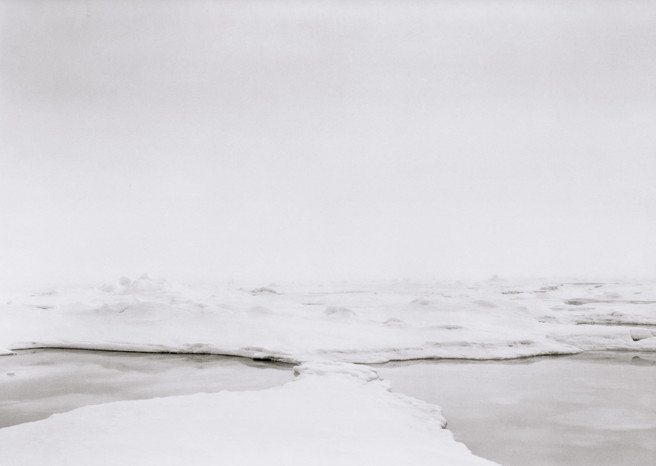
Freezing fog - The Arctic Ocean sea ice, melt lakes and sestrugi. The North Pole, 2007-2008. 90° N pub: "True."
TP: So this is the most Northerly part of Antarctica?
TJC: Yeah, it’s called Prime Head. I’m number nine and my captain’s number ten who have visited there ever. The previous attempts were three Argentine glaciologists who were killed in a crevasse collapse and what we were told by the station commander at the research base is that more people have stood on the face of the Moon, there are 12, than have been on Prime Head point so far and I don’t think anybody’s followed us. We were the very first sea entry to Prime Head too. We had to chart … which is one of the reasons I found the site, we had to chart a trail into … on sea maps it is marked “uncharted, dangerous”, and if you go into those areas, especially on a pilot chart, and you have problems and you radio for help, no-one has to involuntarily come and help you because there’s no chart. If you haul your ship or boat, Lloyds refuses to insure you, so no-one does this. But we went in at great aggravation to my captain I have to admit, I formally took command as the charterer, I said I own the boat, you can put me off, but there’s no place to put me off, or we can go forward. He said, how do you expect to do this, so I said well I don’t know but I would expect the easiest way for us and the safest is to pull the boat with the dinghy, depth sound a chart as we go. It took three weeks to go 50 miles from the Bransfield Straight where it meets the Antarctic Sound.
TP: You were manually depth sounding?
TJC: Manual. An absolute sod, in real weather. We’d been out so long that the austral summer disappears more or less immediately and there’s no real autumn, it goes almost directly to winter, the first bits of winter. We were just so lucky. But it was so wonderful, God. Maybe God will forgive me some of my foolishness and awfulness for getting to that point and making those pictures. I found a speck of land that was known to exist but that hadn’t been charted and I charted it and the hydrographic board has allowed me to name it for my wife, it’s called Katherine Hyland.
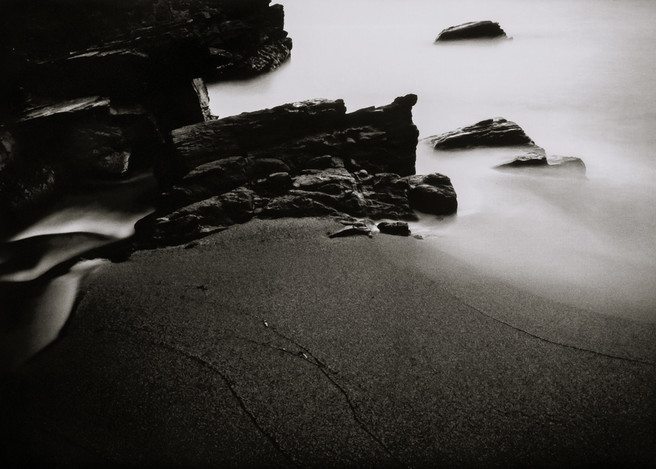
The Mouth of the Stetrin River and Englishman's Bay St. John. The Island of Tobago, 2005 pub: "Eye of the Water."
One Camera, One Lens, One Meter
CMcC: Given all those challenges of getting to places did you only take one camera with you?
TJC: Yeah.
CMcC: What if you drop it?
TJC: Screwed. One lens, one light meter. I’ve broken the light meter on occasions and that’s such a sod. There’s a phrase that appertains to me, I’m as stupid as I look.
CMcC: That’s a massive risk isn’t it, given all the effort and time by you and others, to get to this point.
TJC: When we’re in transit on a dinghy trying to get to this place, they have a process called lurch and clutch where you have to figure out how to get off the boat onto the dinghy and then how to get off the dinghy onto the cliff face and that sounds really simple but the tide is going and the waves are going and we’re in survival suits. The first few times in Antarctica with lurch and clutch I got off the boat at the rise of the wave and of course missed my first step and the dinghy lowers and I fall in, a bad scene, they pull me out, I’m in the dinghy, it’s okay, really scared and lucky I didn’t get too bashed. But I wear glasses and I couldn’t see anything through the glasses and so I had to find something to dry the glasses off which means I had to get back on the goddam boat and I finally get onto the dinghy and get this first cliff face which was actually interestingly one of the three sites that I charted anew which was a proposed new north-west point of Antarctica.
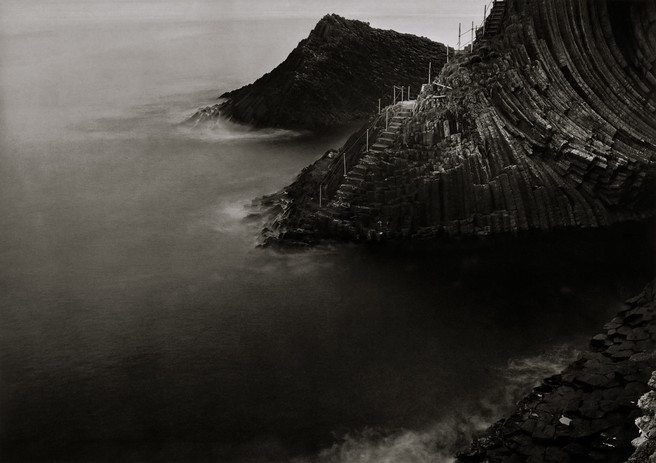
A Premonitional Work - The Giant's Causeway. message for M.S. Emerging. Isle of Staffa, Inner Hebrides. Scotland, 1988 pub: "Dreaming the Gokstadt."
I’m absolutely certain that the current north-west proposal is a misreading. However, on the up swell, grab this rock and I really grabbed it, but I didn’t see it was black ice and the boat or the dinghy dropped and I was dangling and of course, I slipped all the way off against the cliff face and the waves were bashing me and the dinghy was bashing me and I was really disoriented and really frightened. I had no idea where I was, I panicked. Apparently, the captain was telling me what to do and I wasn’t responding and he took an oar and whacked me on the head. It was a real blow and it got my attention and then I figured out how to scramble back into the dinghy and then try the approach again. But you know, the survival suit, you should wear gloves as well but I can’t work the camera with gloves so my hands were screwed, you know. The water is around … somewhere between two and three degrees. You freeze quickly. The survival suit’s kind of fun in a way, for 45 minutes but after you get used to it actually, it’s really pleasant. But learning how to actually get onto the cliff face and then getting the equipment into the dry boxes is such a pain in the arse and then getting them out of the way of the splash zone because salt kills, it corrodes almost instantly, instantaneous corrosion, and that’s the biggest problem. Salt water on the lens is one thing but salt water on the shutter, is really bad. I’ve been seriously lucky because I have had the whole thing, the camera, me, everything, seriously soaked by a giant wave and the only thing I could think to do was put the lens in … intact, in a freshwater plastic bag and leave it there for 24 hours and then everything more or less freeze dries. Before I left I had a Schneider lens that I had them grease it for cold weather and so that helped, but it hit everything, everything. I’m a greenhorn. I mean the real guys, they just look at me and they laugh.
CMcC: You could carry a spare camera
TJC: I could I guess. I have a body with a camera repairman guy who repairs nineteenth century cameras but this is the camera I’ve worked with since I bought it in 1965 from the -
TP: Is it the Gandolfi?
TJC: No I wish. I actually knew Fred and Louis and regret deeply I didn’t interview them for our book. Fred used to fix my dark slides. He just laughed, he said you know, even in the seventies, early seventies, he said to me, what is this thing? I just leave it set up because the more it bends the more it’s going to break, so I carry it and it’s an old five by seven made in Binghamton, New York in 1898 (An Agfa Ansco I think - Tim).
TP: While we’re at that, just because I know people will ask, is a couple of technical things, what lens is it that you use? Is it a Schneider?
TJC: It’s a Schneider Symmar 180mm. Because the 180 is slightly wide on 5x7 (approximately 35mm on full frame), the 210 is normal. But the 180 is … it approximates the view that your eye sees, which is what I want. Then I use … or just recently, as of two weeks ago, I started using … a 210 to print with but now I’m using a 240, simply because there’s so much field damage between x-rays and things that I sometimes have to either print at F/5.6 or … and to print at F/5.6 to get through the x-ray nonsense, that if I don’t have a bigger image circle then things fall off on the edges and it’s just such a pain in the arse at 30 by 40 inches that it’s just unbelievable.
TP: What film do you use?
TJC: I only use Ilford FP4 and I rate it at 80. The developer isn’t made anymore, FG7 with sodium sulphite, and then I use bromophin and then selenium tone everything for intensity and colour. My printing process goes from 5” x 7” contact prints for proofs to 8” x 10” proofs to figure out whether it will scale well, whether it’s a large picture, which means 30” x 40”, or a regular size picture, which is 20” x 24”.
For the paper, which is really important, I have the last remaining supply of Agfa Multi Contrast Classic in the world. It’s going really quickly, the large is anyway. I don’t have many rolls left. I started with 50 and thought that would do it, it was a mistake. I need another 20.
I use only De Vere eight by ten, I swear by them. I don’t know, the Germans may have something better, but I don’t know it. I say this in relation to the again Gandolfi brothers and just a few others, Jesus they were some people with serious knowledge, I was always proud to know, I was just a pisshead. When they talked to me I was amazed you know. I learned a lot from these people.
TP: You seem to use that same camera all the time.
TJC: I bought this camera in 1965 from the 70 year old son of the original owner. He, the original owner obviously bought it in New York and used it as a portrait camera. The son came west to California at some point and became a portrait photographer, sold out at the age of 70 his business, to me, for $300 or $500 which seemed like a bunch but really wasn’t. It included a five by seven diffused light Elwood enlarger, impossible to use and all its bits, but it was the camera that I wanted and I looked at it for two years and then from 1967 till ’69 I worked with it for two years until I figured out how to use it properly and then from then 1969 until today it’s the only camera I have. It’s just perfect for me.
---
And at that point I think hunger overcame the will to continue and after a brief tour of the darkroom (I so want a De Vere 5108!) we parted our ways. I was left with the impression of a man with a devilishly strong sense of direction and forward momentum. Even if Thomas doesn't know the complete path he's taking, he knows which bearing to follow and at most points finds himself somewhere interesting - and considering the amount of miles he's covered in his various projects, that can be very, very interesting!
A big thank you to Colin McClean, Thomas Joshua Cooper and his wife Kate for the patience to get this article published. If you have any questions about the article or about Thomas' work, please let me know and we'll try and answer them.
If you're interested in finding out more about Thomas, you could buy one of these books
Between Dark and Dark, published by Graeme Murray, Edinburgh, 1985
Dreaming the Gokstadt, published by Graeme Murray, Edinburgh, 1988
Point of No Return, published by Haunch of Venison, London, 2004
Eye of the Water, published by Pace Wildenstein, New York, 2007
True, published by Haunch of Venison, London, 2009
Shoshone Falls, published by Radius Books, Santa Fe, 2010
Scattered Waters, published by Ingleby Gallery, Edinburgh, 2014
I'd recommend Between Dark and Dark and Scattered Waters but check out the images in this article which mention which book they are found in.
If you enjoyed this article, also read:
Thomas Joshua Cooper's Lecture at our Meeting of Minds Conference 2018
Also, see Beyond Word's exclusive signed & out of print books of Thomas's
You can also visit these links for some more info
http://www.inglebygallery.com/artists/thomas-joshua-cooper/
http://bellabathurst.com/thomas-joshua-cooper/
and watch these fabulous videos
- Thomas Joshua Cooper by photographer: Laura Indigo Cooper
- Lingering Twilight – The First View – Shoshone Falls Centre Rim Top, The Snake River Basin. The Twin Falls and Jerome County border line, 2003-2004 pub: “Shoshone Falls.”
- “Bridal Falls” – Shoshone Falls – The Snake River Basin The West Bank Rim Top, Jerome County, Part 1 of a 2 part work, 2003-2004 pub: “Shoshone Falls.”
- Shoshone Falls and the Snake River Basin The East Bank Rim Top, Twin Falls County, 2003-2004 pub: “Shoshone Falls.”
- Divided – A Premonitional Work Malin Head, County Donegal, Ireland, 1986 pub: “Dreaming the Gokstadt.”
- A Quality of Dancing – Ceremonial Dwelling (small animal nesting ground) San Jose Canyon, New Mexico, 1973 pub: “Between Dark and Dark.”
- Ritual Ground Nescliffe, Shropshire, England, 1975 pub: “Between Dark and Dark.”
- Further West – The Mid Atlantic Ocean Overlooking Tarrfal de Monte Trigo and Ponte Cháo de Mangrade. The Isle of Santo Antáo, Ilhasde Barlavento. The Cape Verde Islands, 2004. The West-most point of The Cape Verde Islands and of all Africa. pub: “Point of no return.”
- Wind – Riffling Memories The Connemara. Ireland, 1976-86 pub: “Dreaming the Gokstadt.”
- An Indication – Ritual Ground Ledlewan, Old Stirlingshire. Scotland, 1988 pub: “Dreaming the Gokstadt.”
- The Guardian Cycle – A Premonitional Work nr. Sonder Vissing, Braestrup Region. Denmark, 1988 pub: “Dreaming the Gokstadt.”
- A Premonitional Work – The Giant’s Causeway. message for M.S. Emerging. Isle of Staffa, Inner Hebrides. Scotland, 1988 pub: “Dreaming the Gokstadt.”
- The South Atlantic Ocean Cape Dolphin. East Falkland Island. The Falkland Islands – Islas Malvinas. The United Kingdom, 2006. Very near the North-most point of the Islands pub: “Eye of the Water.”
- The South Atlantic Ocean Ponta Jose Ignacias. Maldonado, Uruguay, 2006. pub: “Eye of the Water.”
- The Mouth of the Stetrin River and Englishman’s Bay St. John. The Island of Tobago, 2005 pub: “Eye of the Water.”
- Kangertittivaq / Scorebysund – The Denmark Strait Kangikajik / Kap Brewster, 6 a.m. Liverpool Land, Tunu / Ost / East. Kalaalit Nunaat / Grønland / Greenland, 2007-2008. From the longest fjord in the world. 70° 09.097‘ N pub: “True.”
- the Wild West – The North Sea – The Norwegian Sea Near Kolgróv. The Isle of Ytra Sula. Norway, 2004-2008. Very near the West-most point of Norway. 61°01.099‘ N pub: “True.”
- Moonlight – West, Southwest – The Mid Atlantic Ocean Cap Manuel, Dakar The Cape Verde Peninsula, Senegal, 2004 The South-most point of The Cape Verde Peninsula
- Freedom Day – Southwest – Table Bay. Looking Toward Cape Town and Remembering Robben Island, Cape Town. South Africa, 2004. pub: “Point of no return.”
- freezing fog – The Arctic Ocean sea ice, melt lakes and sestrugi. The North Pole, 2007-2008. 90° N pub: “True.”
- whirl – the Sea-River – early Evening – the Spring High Tide at Flood The Corryveckan whirlpool. The Gulf of Corryveckan. The Isle of Jura. Looking toward the Isle of Scarba. Argyllshire. Scotland, 1991/2014 (a three part work) pub: “Scattered Waters.”
- Mid-Morning – The Source Stream of the River Forth rising from Loch Chon Near Inversnaid, Stirlingshire, Scotland, 1997 / 2014 pub: “Scattered Waters.”
- Late Afternoon – remembering lost holidays – The River Devon Rumbling Beside Gorge. Kinross-shire, Scotland, 2014 pub: “Scattered Waters.”

